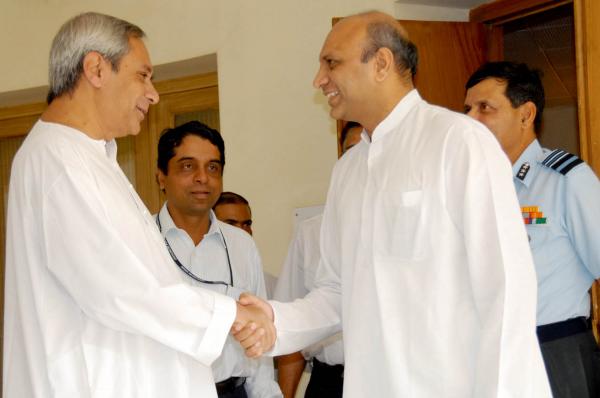Orissa: Wildlife conservation strategy must address biological requirements says CM


Naveen Patnaik`s adress at National workshop on `Management of Endangered Species’.
India is one among the twelve mega - biodiversity countries in the world with rich heritage of wildlife resources ranging from iconic lions, tigers and elephants to thousands of little known species of plants and animals. The fauna and flora of our country constitute about 8 percent of the world’s bio-diversity. You are aware that from time immemorial, our beliefs, folklores, epics and our history have been closely associated with the wildlife.
The State of Odisha has the distinction of possessing rich biodiversity which includes more than 3000 species of plants, 20 species of amphibians, 110 species of reptiles, 473 species of birds and 86 species of mammals. Odisha is the only State in our country where all the three species of Indian crocodilians are naturally distributed in rivers, marshy lands and estuaries. The State has also the distinction of being the largest nesting ground of endangered Olive Ridley turtles.
The mangrove diversity in Bhittarkanika, the bird congregation in Chilika, the White tigers of Nandankanan, Similipal Biosphere Reserve and other protected areas of the State are notable examples of our efforts in the conservation of wildlife. The local communities in many areas of our State have contributed significantly towards the wildlife conservation. The conservation of black bucks in Bhetnoi area of Ganjam district by the local communities is worth mentioning. The State Government has also undertaken various initiatives for conservation of elephants and to minimize the man - animal conflicts.
The State Government has established 18 wildlife sanctuaries and two National Parks in the State which covers more than 5 percent of the geographical area of the State.
Today, many of the species in our Country have been subjected to severe biotic pressures. There has been degradation and fragmentation of their natural habitats. The biodiversity is the basis of sustenance of life on earth. We have to design the wildlife management for peaceful co-existence of all forms of life. People from all walks of life have to join their hands towards ensuring effective conservation of our wildlife resources. The wildlife conservation strategy must address the biological requirements of different fauna along with the needs of the communities. The State Government has already taken several initiatives towards conservation of forests and wildlife in the State in consonance with the National Forest Policy, 1988.
The zoological parks have been established at various locations of our country to create awareness amongst the public about wildlife conservation. One of the main objectives of zoo management is the ex-situ conservation of wild fauna. The zoos have not only to sustain their own wild animal populations but also have to work for the augmentation of the depleting population of endangered species in the wild. Another important objective of the modern zoo management is to complement and strengthen the efforts for conservation of biodiversity particularly the wild fauna. This can be achieved by supporting the conservation of the endangered species through coordinated breeding under ex-situ conditions.
The wild animal stock of healthy individuals of each critically endangered wild animal species in captivity can act as an insurance cover in case of population loss of the species in the wild. The re-introduction of the endangered species in the wild should be a planned and coordinated programme between the wildlife managers working in the Zoological Parks as well as in the protected areas. Another important component in the conservation of the endangered species is to identify the protected areas having wild populations of the critically endangered species. Sincere attempts should be made to assess and analyze carefully the causes of decline of the species in their natural habitats so that necessary management inputs can be applied for improvement of the natural habitat and also for effective protection of the target species. Most of the zoos in our country are equipped with basic facilities for coordinating and participating in the conservation breeding programme of the endangered species. I am happy to know that the Central Zoo Authority of the Ministry of Environment and Forests, Govt. of India have identified 70 endangered wild animal species for the conservation breeding programme in various zoological parks in our Country.
Nandankanan Zoological Park was established in December, 1960 and was notified as a Wildlife Sanctuary in the year 1979 along with the State Botanical Garden and Kanjia lake. Nandankanan has contributed in a big way to ex-situ and in-situ conservation of wildlife. The year 2010 is being celebrated as the Golden Jubilee Year of Nandankanan Zoological Park which coincides with the `International year of Biodiversity’. Nandankanan is a pioneer Zoological Park in our country known for white tigers and captive breeding of crocodiles and wildlife research. The conservation breeding programme of endangered Gharials has been successfully implemented in Nandankanan.
The first captive breeding of the species was done in the year 1980 at a time when the gharials were facing extinction in the wild. The captive - bred gharials were released in their natural habitats and the species have been successfully rehabilitated. The Zoological Park has also taken up conservation breeding programme of endangered Indian Pangolin. Efforts are also being made for conservation breeding of white backed vultures and water monitor lizard.
This National workshop on `Management of Endangered Species’ has been organized among other events to mark the Golden Jubilee Celebration of Nandankanan Zoological Park. I thank the Central Zoo Authority for their support in this endeavour.
The Zoo Managers, Biologists, Veterinarians and Scientists coming from different States will be deliberating on the relevant issues for the coming four days which, I am sure, will certainly contribute to the protection and conservation of the wildlife resources for maintaining the ecological integrity of our Country.
I wish this National Workshop all success.
|
|
